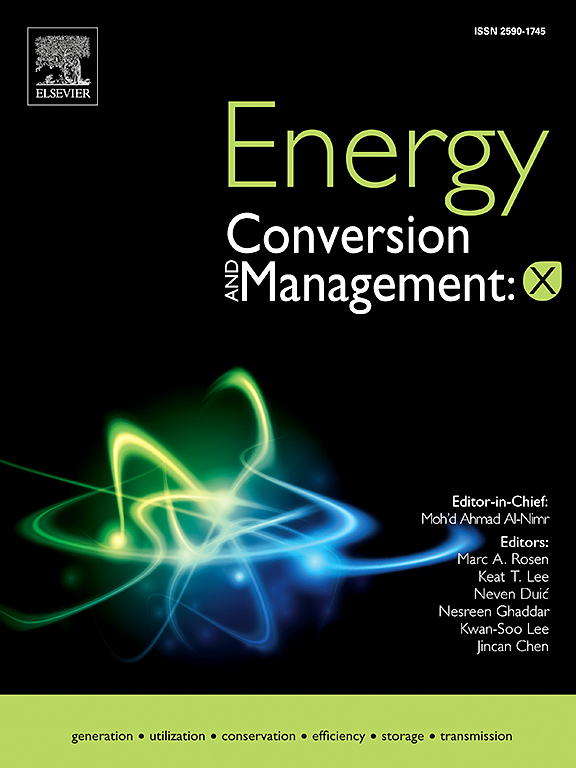Exergy-based cost and carbon footprint analyses of a combined cooling, heating, and power system with reliability consideration
IF 9.9
1区 工程技术
Q1 ENERGY & FUELS
引用次数: 0
Abstract
Combined cooling, heating, and power systems have made considerable progress in the fields of energy conservation and carbon reduction owing to their ability to achieve energy coupling and cascaded utilization. With increasing complexity of these systems, evaluating their carbon emissions and operational reliability has become a critical issue. This study proposes a modified exergy-based cost and carbon footprint method, incorporating reliability considerations and based on energy level, to establish a comprehensive framework for assessing carbon emissions and conducting economic analysis of complex energy systems. This method aims to explore the cost and carbon footprint allocation of electricity, domestic hot water, and air conditioning water within the investigated system. The results reveal that in summer, the carbon footprint of electricity of internal combustion engine, electricity of organic Rankine cycle, chilled and heating water, and domestic hot water were 151.78, 7.27, 241.95, and 83.59 kg CO2-eq/h, respectively. In winter, the corresponding values were 154.73, 7.27, 73.11, and 83.63 kg CO2-eq/h, respectively. With reliability considered, the unit exergy carbon costs of the same four in summer were 178.877, 156.003, 638.669, and 1168.803 $/MWh, while in winter, the corresponding values were 173.874, 147.706, 363.057, and 1178.060 $/MWh, respectively. Additionally, sensitivity analysis was conducted to evaluate the effects of economic and physical factors on the exergy carbon cost of the system products. These analyses demonstrate the robustness of the proposed framework for assessing the economic and carbon emissions of energy systems.
考虑可靠性的冷、热、电联合系统基于火用的成本和碳足迹分析
冷热电联产系统由于能够实现能量耦合和级联利用,在节能减排领域取得了长足的进步。随着这些系统的日益复杂,评估其碳排放和运行可靠性已成为关键问题。本研究提出了一种改进的基于火用的成本和碳足迹方法,结合可靠性考虑,并基于能源水平,建立一个综合的框架来评估碳排放并进行复杂能源系统的经济分析。该方法旨在探索被调查系统内电力、生活热水和空调用水的成本和碳足迹分配。结果表明,夏季内燃机电、有机朗肯循环电、冷热水和生活热水的碳足迹分别为151.78、7.27、241.95和83.59 kg CO2-eq/h。冬季对应值分别为154.73、7.27、73.11和83.63 kg CO2-eq/h。在考虑可靠性的情况下,这四家电厂的单位火用碳成本在夏季分别为178.877、156.003、638.669、1168.803 $/MWh,在冬季分别为173.874、147.706、363.057、1178.060 $/MWh。通过敏感性分析,评价了经济因素和物理因素对系统产品火用碳成本的影响。这些分析证明了所提议的评估能源系统经济和碳排放的框架的稳健性。
本文章由计算机程序翻译,如有差异,请以英文原文为准。
求助全文
约1分钟内获得全文
求助全文
来源期刊

Energy Conversion and Management
工程技术-力学
CiteScore
19.00
自引率
11.50%
发文量
1304
审稿时长
17 days
期刊介绍:
The journal Energy Conversion and Management provides a forum for publishing original contributions and comprehensive technical review articles of interdisciplinary and original research on all important energy topics.
The topics considered include energy generation, utilization, conversion, storage, transmission, conservation, management and sustainability. These topics typically involve various types of energy such as mechanical, thermal, nuclear, chemical, electromagnetic, magnetic and electric. These energy types cover all known energy resources, including renewable resources (e.g., solar, bio, hydro, wind, geothermal and ocean energy), fossil fuels and nuclear resources.
 求助内容:
求助内容: 应助结果提醒方式:
应助结果提醒方式:


